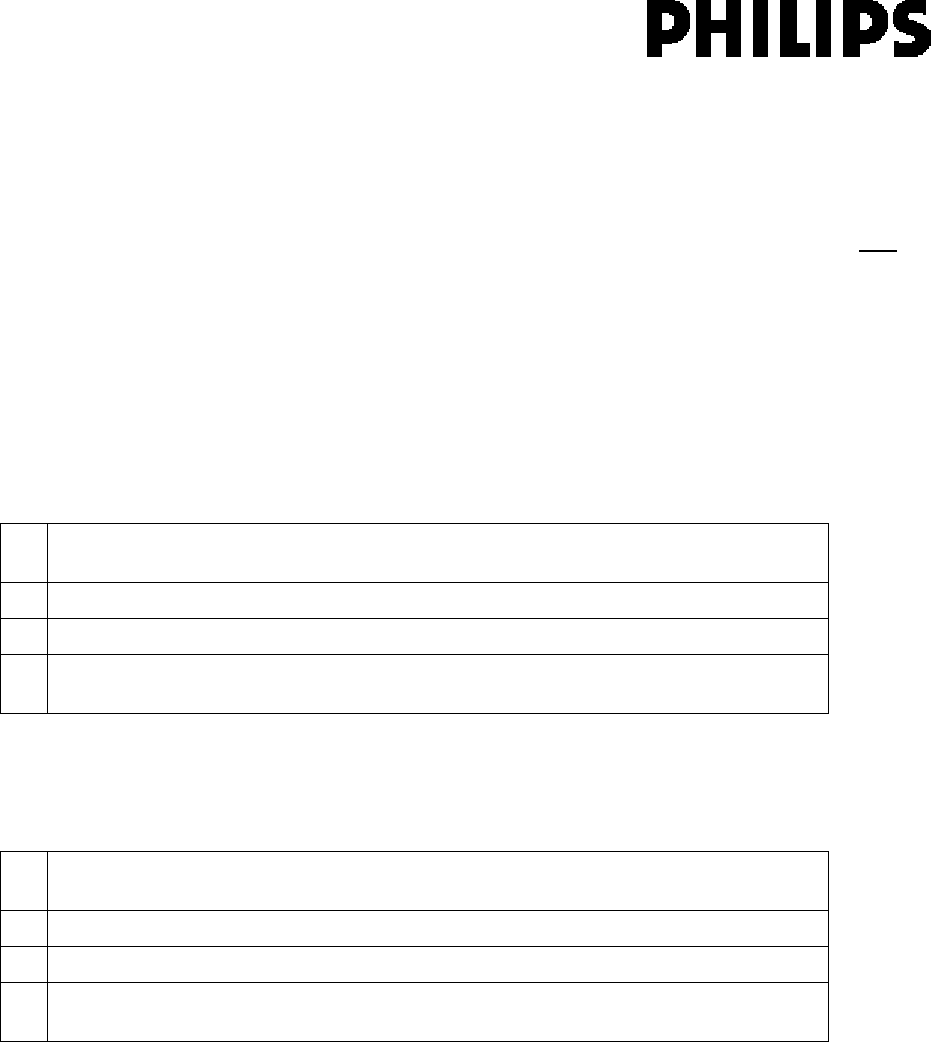Philips Electronics Singapore RC18049IR2RF Rothko Remote Control User Manual
Philips Electronics Singapore Pte Ltd Rothko Remote Control
user manual

Specificationsaresubjecttochangewithoutnotice
Manual of RC1804948/01B, Rothko
[Note: This document also applicable to RC18049xx/01 or RC18049xx/01B or RC18049xx/01BS, where
xx vary from 47 to 61]
RC18049xx/01B
Model 12NC Alternate P/N Description
RC1804947/01B 3139 228 11181 684257-001 Rothko Non-Teletext NA Flash
RC1804948/01B 3139 228 11221 684258-001 Rothko Non-Teletext NA OTP
RC1804949/01B 3139 228 11231 684257-L31 Rothko Teletext EMEA Flash
RC1804950/01B 3139 228 11241 684258-L31 Rothko Teletext EMEA OTP
RC1804951/01B 3139 228 11331 684257-371 Rothko NonTeletext AP LA Flash
RC1804952/01B 3139 228 11341 684258-371 Rothko Non-Teletext AP LA OTP
RC1804953/01B 3139 228 11411 684259-001 Rothko Non-Teletext NA OTP with dongle
RC1804954/01B 3139 228 11431 684259-L31 Rothko Teletext EMEA OTP with dongle
RC1804955/01B 3139 228 11451 684259-371 Rothko Non-Teletext AP LA OTP with dongle
RC1804956/01B 3139 228 11551 684257-AA1 Rothko Non-Teletext S-CH Flash
RC1804957/01B 3139 228 11561 684258-AA1 Rothko Non-Teletext S-CH OTP
RC1804958/01B 3139 228 11571 684259-AA1 Rothko Non-Teletext S-CH OTP with dongle
RC1804959/01B 3139 228 11591 684257-AD1 Rothko Non-Teletext KOREA Flash
RC1804960/01B 3139 228 11601 684258-AD1 Rothko Non-Teletext KOREA OTP
RC1804961/01B 3139 228 11611 684259-AD1 Rothko Non-Teletext KOREA OTP with dongle

Specificationsaresubjecttochangewithoutnotice
FCC Statement
Federal Communication Commission Interference Statement
This equipment has been tested and found to comply with the limits for a Class B digital device,
pursuant to Part 15 of the FCC Rules. These limits are designed to provide reasonable
protection against harmful interference in a residential installation. This equipment generates,
uses and can radiate radio frequency energy and, if not installed and used in accordance with
the instructions, may cause harmful interference to radio communications. However, there is no
guarantee that interference will not occur in a particular installation. If this equipment does cause
harmful interference to radio or television reception, which can be determined by turning the
equipment off and on, the user is encouraged to try to correct the interference by one of the
following measures:
● Reorient or relocate the receiving antenna.
● Increase the separation between the equipment and receiver.
● Connect the equipment into an outlet on a circuit different from that to which the receiver is
connected.
● Consult the dealer or an experienced radio/TV technician for help.
FCC Caution: Any changes or modifications not expressly approved by the party
responsible for compliance could void the user’s authority to operate this equipment.
This device complies with Part 15 of the FCC Rules. Operation is subject to the following two conditions:
(1) This device may not cause harmful interference, and (2) this device must accept any interference
received, including interference that may cause undesired operation.

Specificationsaresubjecttochangewithoutnotice
IC Statement:
This Class B digital apparatus complies with Canadian ICES-003.
Cet appareil numérique de la classe B conforme á la norme NMB-003 du Canada.
This device complies with Industry Canada license-exempt RSS standard(s). Operation is
subject to the following two conditions: (1) this device may not cause interference, and (2) this
device must accept any interference, including interference that may cause undesired operation
of the device.
LeprésentappareilestconformeauxCNRd'IndustrieCanadaapplicablesauxappareilsradioexemptsde
licence.L'exploitationestautoriséeauxdeuxconditionssuivantes:(1)l'appareilnedoitpasproduirede
brouillage,et(2)l'utilisateurdel'appareildoitacceptertoutbrouillageradioélectriquesubi,mêmesile
brouillageestsusceptibled'encompromettrelefonctionnement.

Specificationsaresubjecttochangewithoutnotice
1.1 RF Pairing
Whenthereismorethan1pairofremoteandReceiverworkinginaneardistance,interferencemay
occur,thustheremotehastopairwiththeReceivertogenerateaspecificaddresstoovercomethe
interference.
RFpairingisbyproximitypairingmethod.TheremoteneedstobeinRFPairingmodeandwithin6cm
awayfromtheReceiver.
TheReceiverpairingpipeisalwaysopenforpairing.WheneveraremoteinPairingModeiswithin
pairingproximity,bothremoteandReceiverwillbepaired.
Shouldtherebe2Receiverspresentduringpairingprocedure,theremoteistopairwithany1receiver
thatpassestheproximitytest.
RFpairingtimeoutwillbe2mins.
Wheneverpairingfails,thepreviouspairingentry(iftherewasapreviousentry)shouldnotbedeleted.
1 Bring the remote within 6cm distance from the host and make sure no other remote is
present.
2 Press and hold keys <INFO> and <#> for 5secs.
3 The LED turns On and goes into RF Pairing mode.
4 Upon completion of pairing, the LED will blink 2 times and the remote will exit the RF
Pairing mode.
1.2 RF Quick Pairing
Thereisaquickpairingmodeforfactorytestingatthedonglemakers’factories.Forquickpairingthere
isnoneedtowaitfor5seconds.
1 Bring the remote within 6cm distance from the host and make sure no other remote is
present.
2 Press and hold keys <INFO> and <#> and <Print>
3 The LED turns On and goes into RF Pairing mode.
4 Upon completion of pairing, the LED will blink 2 times and the remote will exit the RF
Pairing mode.
1.3 RF Auto Connection
WhentheremotewakesuporresumesfromSLEEP/STANDBYorcomebackwithinrangeofapoweron
pairedReceiver,RFlinkwillbere‐connectedautomatically.NoRFre‐pairingisneeded.
1.4 RF Pairing Limitation
TheremotethatusestheOTPICmayonlybepairedwithanotherdeviceuptoamaximumof64times.
Whenthepairingdevicelimitisreached,thereisachancetheremotewillnotbeabletopairwith
anotherdevice.

Specificationsaresubjecttochangewithoutnotice
1.5 Indicator LED
LED Indication Purpose Status Description
“RF” Blink to indicate Pairing On for 2 min or until it is paired.
“RF” Pairing Success 2 blinks when pairing passes.
“RF” Pairing Failure 4 blinks when pairing fails.
“RF” Blink to indicate RF transmission (RC RF
transmission)
1 short blink when valid key is sent.
There is a minimum 2 blinks for a short
key press.
*Note:ForotherLEDindicationofotherremotefeatures,refertorespectivefeatures.

Specificationsaresubjecttochangewithoutnotice
2. Power Management
Thefollowingproperpowermanagementforbatteryenergyconservationisneeded,toachievethe
indicatedbatterylife.
Power State RC Function RF Link
ACTIVE,
instantaneous
response
Active Active
SLEEP,near
instantaneous
response
Sleep (RTC turned
off), need to press
a key to activate.
Sleep (RTC turned
off), need to press
a key to activate
2.1 Stuck Mode
StuckKeymeansthatabuttonhasbeenpressedforaverylongtimeinnormaloperatingmode.To
preservebatterypower,theremotewillstoptransmissionabout30secondsafterthelastkeytransition
toconsumeminimalpower.Afterallkeysarereleased,theremoteresumesnormaloperation.
Inthismode,anyindicatorLEDwillbeoffandnosignaltransmission.
Followinggraphicshowswhenthispowerdownmodeisentered:
2.2 Simultaneous Key Press
ForRCkeys,ifmorethanonebuttonispressedsimultaneously,RFtransmissionwillstopinorderto
conservebatterylife.StuckModeappliesforsimultaneouskeypress.Ifthesecondorthirdkeyis
releaseduntilthereisonly1keypressed,theRFtransmissionoftheremainingkeypresswillbesent.
2.3 Active Mode
Wheninthismode,remoteshouldhaveinstantaneousresponse.ForRFtransmission,instantaneous
responseisprovidedwhenRFlinkissufficientlygood.
2.4 Sleep Mode
WheninSLEEPmode,anykeypresswillwakeupMCUfromSLEEPmode.Whentheremotewakesup
fromSLEEPmode,theremaybere‐connectionlatencydependingontheRFlinkconditionwiththe
receivers.